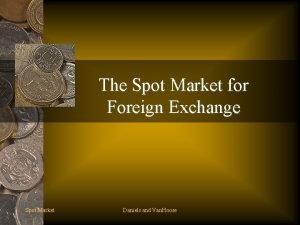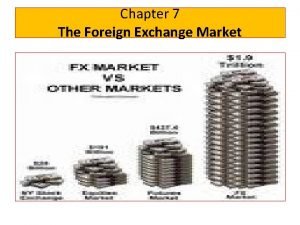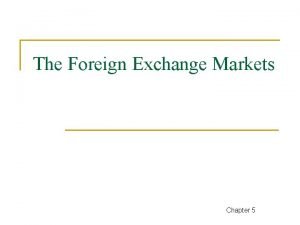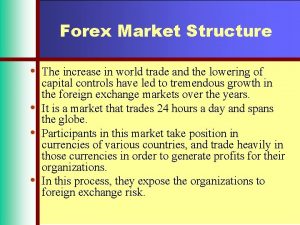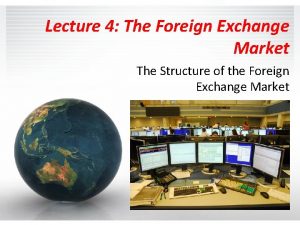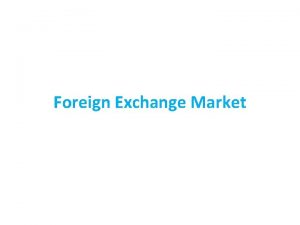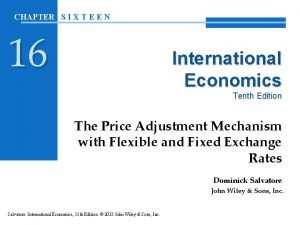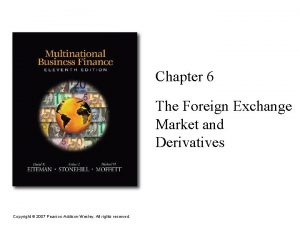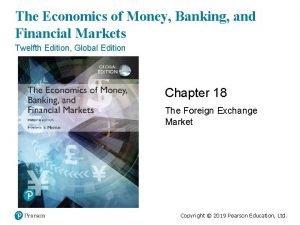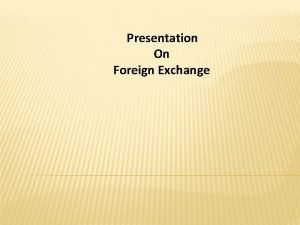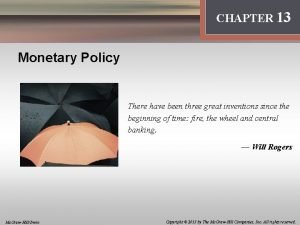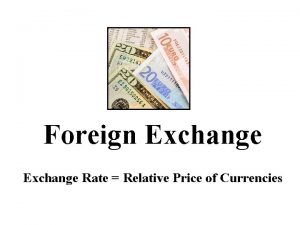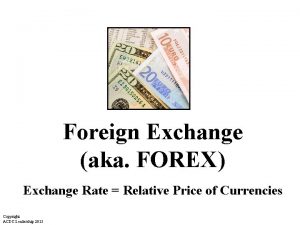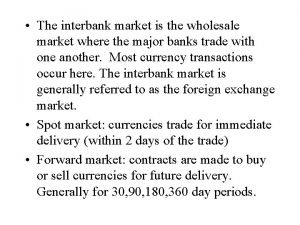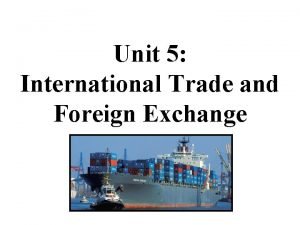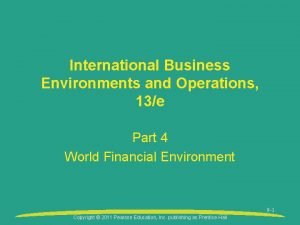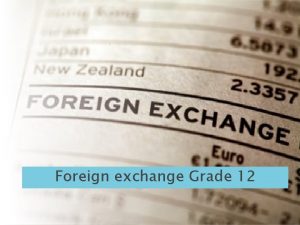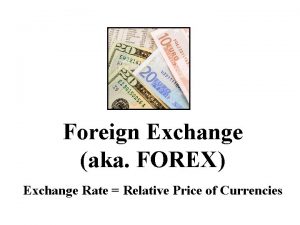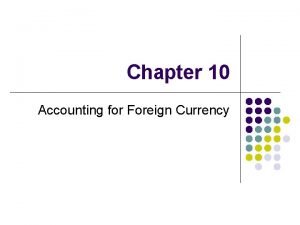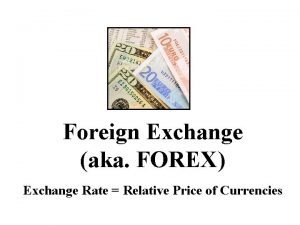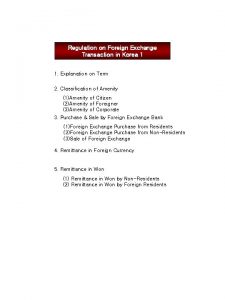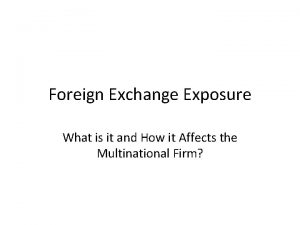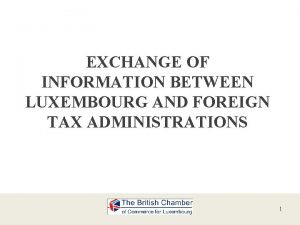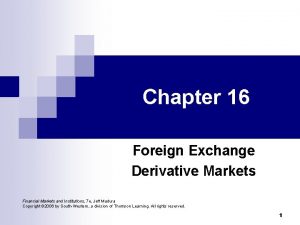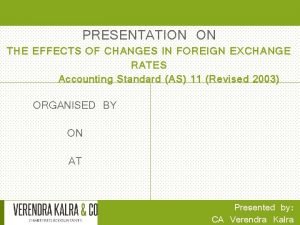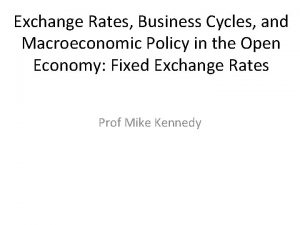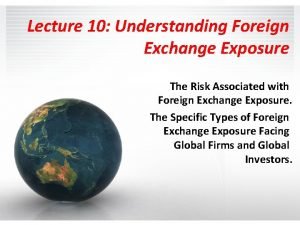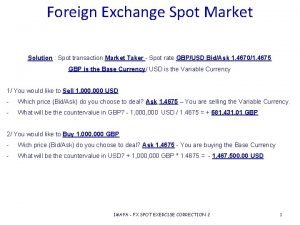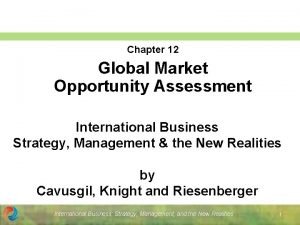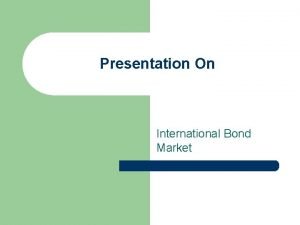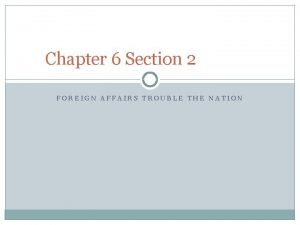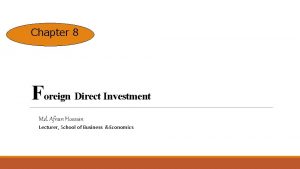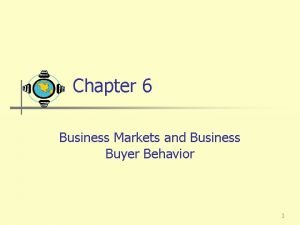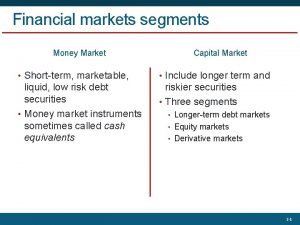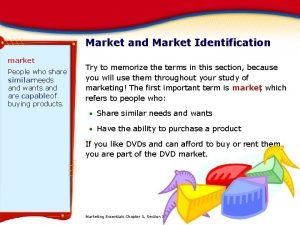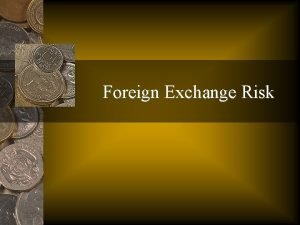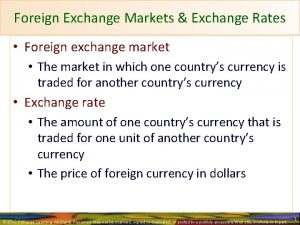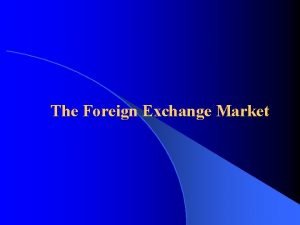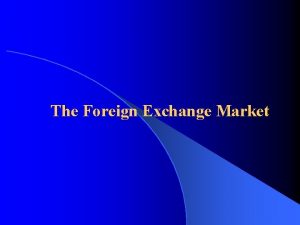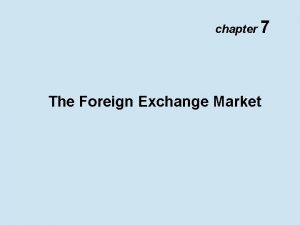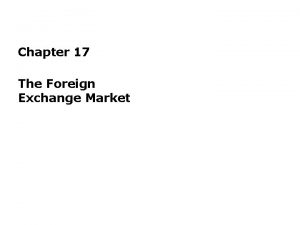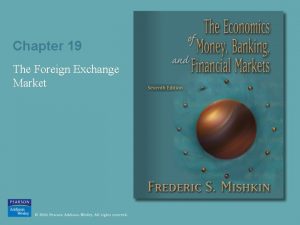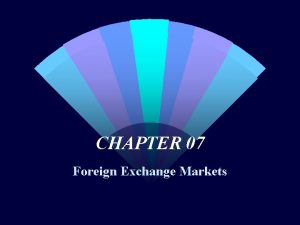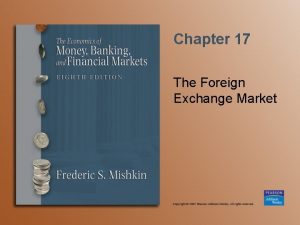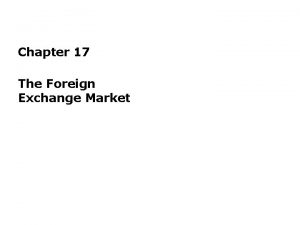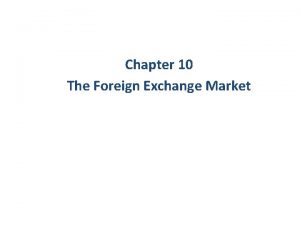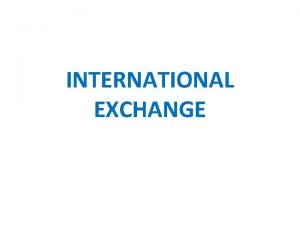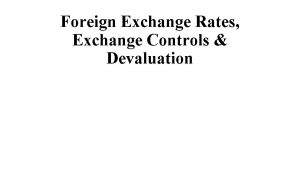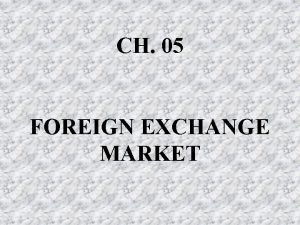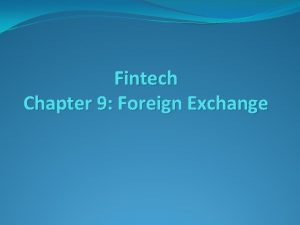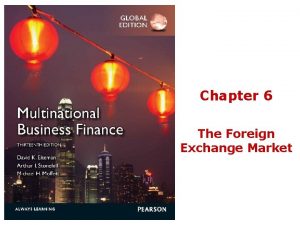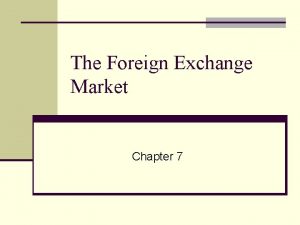Chapter 11 The foreign exchange market and exchange



























































- Slides: 59

Chapter 11 The foreign exchange market and exchange rates

Key terms Foreign exchange market Foreign exchange risk Euro Hedging Speculation Exchange rate Depreciation Appreciation Stabilizing speculation Destabilizing speculation Cross exchange rates 外汇交易市场 外汇交易风险 欧元 套期保值 投机 汇率 贬值 升值 稳定性投机 不稳定投机 交叉汇率

Key terms Effective exchange rates Arbitrage Spot rate Forward discount Forward premium Foreign exchange futures Foreign exchange option Uncovered interest arbitrage parity Covered interest arbitrage Offshore deposits 有效汇率 套利 即期汇率 远期贴水 远期升水 外汇期货 外汇期权 无抛补的利率套利 抛补的套利交易 离岸存款

11. 1 Introduction Definition of the Foreign exchange markets: The “place” where individuals, firms, and banks buy and sell foreign currencies or foreign exchange. These different monetary centers are connected electronically and are in constant contact with one another, thus forming a single international foreign exchange market.

http: //research. stlouisfed. org/fred 2/categories/15

http: //www. xe. com (2007年 12月10日美元汇率)

11. 2 Functions of the exchange rate markets 1. The principal function Transfer of funds or purchasing power from one nation and currency to another. This is usually accomplished by an electronic transfer and increasingly through the Internet (facilitate).

Continued: 11. 2 Functions of the exchange rate markets 2. A second function of foreign exchange markets is the credit function. Credit is usu. needed when goods are in transit and also to allow the buyers’ time to resell the goods and make the payment. In general, exporters allow 90 days for the importers to pay.

Continued: 11. 2 Functions of the exchange rate markets 3. Another function of foreign exchange markets is to provide the facilities for hedging and speculation (discussed in section 11. 9). Today, about 90 percent of foreign exchange trading reflects purely financial transactions and only 10 percent trade financing.

11. 3 Equilibrium exchange rate 1. Exchange rate: The domestic currency price of the foreign currency. The exchange rate between the dollar and the euro (R) is equal to the number of dollars needed to purchase one euro. That is, R=$/ €, if R=$/ € =1, this means that one dollar is required to purchase one euro.

Continued: 11. 3 Equilibrium exchange rate R=$/ € 2. 00 · S€ A 1. 50 2. The determination of the equilibrium rate · F · B G · · E’ 1. 00 0. 50 · H · C 50 100 150 200 250 300 350 D€ Million € /day

Continued: 11. 3 Equilibrium exchange rate 3. Depreciation refers to an increase in the domestic price of the foreign currency. If the U. S. demand curve for euros shifted up (e. g. , as a result of increased U. S. tastes for EMU goods) and intersected the U. S. supply curve for euros at point G (see Figure 11. 1), the equilibrium exchange rate would be R = 1. 50, and the equilibrium quantity of euros would be € 300 million per day. The dollar is then said to have depreciated since it now requires $1. 50 (instead of the previous $1) to purchase one euro.

Continued: 11. 3 Equilibrium exchange rate 4. Appreciation refers to a decline in the domestic price of the foreign currency. Consider the case of downward shift of the U. S. demand curve for euros (D€). if the U. S. demand curve for euros shifted down so as to intersect the U. S. supply curve for euros at point H (see Figure 11. 1), the equilibrium exchange rate would fall to R = 0. 5 and the dollar is said to have appreciated (because fewer dollars are now required to purchase one euro).

11. 4 Cross exchange rates, effective exchange rates, and arbitrage So far we have dealt with only two currencies for simplicity, in reality there are numerous exchange rate, one between any pair of currencies. Thus, besides the exchange rate between the U. S. dollar and the euro, there is exchange rate between the U. S. dollar and British pound(£) , between the Swiss franc and the Mexican peso, and like exchange rates.

Continued: 11. 4 Cross exchange rates, effective exchange rates, and arbitrage 1. Cross exchange rate—The exchange rate between currency A and currency B, given the exchange rate of currency A and currency B with respect to currency C. For example, if the exchange rate (R) were 2 between the U. S. dollar and the British pound and 1. 25 between the dollar and the euro, then the exchange rate between the pound and the euro would be 1. 60 (i. e. , it takes € 1. 6 to purchase 1€). Specifically, R= €/£ =$ value of £/ $ value of €=2/1. 25=1. 60

Continued: 11. 4 Cross exchange rates, effective exchange rates, and arbitrage 2. Effective exchange rate—A weighted average of the exchange rates between the domestic currency and the nation’s most important trade partners, with weights given by the relative importance of the nation’s trade with each of these trade partners. Case Study 11 -4 gives the effective exchange rate of the U. S. dollar from 1972 to 2003.

Continued: 11. 4 Cross exchange rates, effective exchange rates, and arbitrage 3. Arbitrage—The purchase of a currency in the monetary center where it is cheaper for immediate resale in the monetary center where it is more expensive in order to make a profit.

Continued: 11. 4 Cross exchange rates, effective exchange rates, and arbitrage This refers to the purchase of a currency in the monetary center where it is cheaper, for immediate resale in the monetary center where it is more expensive, in order to make a profit: For example, if the dollar price of the euro was $0. 99 in New York and $1. 01 in Frankfurt, an arbitrageur (usually a foreign exchange dealer of a commercial bank) would purchase euros at $0. 99 in New York and immediately resell them in Frankfurt for $1. 01, thus realizing a profit of $0. 02 per euro.

Continued: 11. 4 Cross exchange rates, effective exchange rates, and arbitrage While the profit per euro transferred seems small, on € 1 million the profit would be $20, 000 for only a few minutes’ work. From this profit must be deducted the cost of the electronic transfer and the other costs associated with arbitrage. Since these costs are very small, we will ignore them here.

Continued: 11. 4 Cross exchange rates, effective exchange rates, and arbitrage As arbitrage takes place, the exchange rate between the two currencies tends to be equalized in the two monetary centers. Continuing our example, we see that arbitrage increases the demand for euros in New York, thereby exerting an upward pressure on the dollar price of euros m New York At the same time the sale of euros in Frankfurt increases the supply of euros there, thus exerting a downward pressure on the dollar price of euros in Frankfurt. This continues until the dollar price of the euro quickly becomes equal in New York and Frankfurt (say at $1 = € 1), thus eliminating the profitability of further arbitrage.

11. 5 The exchange rates and the balance of payment R=$/ € 2. 00 · 1. 50 0. 50 · · · E’ · · W · E 1. 00 S€ Z · · D’ € C 50 100 150 200 250 300 350 D€ Million € /day We can examine the relationship between the exchange rate and the nation balance of payments with Figure 11. 3, which is identical to Figure 11. 1, except for the addition of the new demand curve for euros labeled D’ €.

11. 6 Spot and forward exchange rates The most common type of foreign exchange transaction involves the payment and receipt of the foreign exchange within two business days after the day the transaction is agreed upon. 1. Spot rate—the exchange rate in foreign exchange transactions that calls for the payment and receipt of the foreign exchange within two business days from the date when the transaction is agreed upon. The two-day period gives adequate time for the parties to send instructions to debit and credit the appropriate bank accounts at home and abroad. This type of transaction is called a spot transaction.

Continued: 11. 6 Spot and forward exchange rates 2. Forward rate—the exchange rate in foreign exchange transactions involving delivery of the foreign exchange one, three, or six months after the contract is agreed upon. A forward transaction involves an agreement today to buy or sell a specified amount of a foreign currency at a specified future date at a rate agreed upon today.

Continued: 11. 6 Spot and forward exchange rates The specified future date are usually farther away than two days— 30 days(1 month), 90 days(3 months), 180 days(6 months), or even several years, with 3 months the most common. At any point in time, the forward rate can be equal to, above, or below the corresponding spot rate. (An example at page 292, third paragraph)

Continued: 11. 6 Spot and forward exchange rates 3. Forward discount—the percentage per year by which the forward rate on the foreign currency is below its spot rate. 4. Forward premium—the percentage per year by which the forward rate on the foreign currency is above its spot rate. For example, if the spot rate is $1= € 1 and the three-month forward rate is $0. 99=€ 1, we say that the euro is at a threemonth forward discount of 1 cent or 1 percent (4 percent per year) with respect to the dollar. On the other hand, if the spot rate is still $1= € 1, but the three-month forward rate is instead $1. 01= € 1, the euro is said to be at a forward premium of 1 cent or 1 percent for three months, or premium per year.

Continued: 11. 6 Spot and forward exchange rates Forward discounts (FD) or premiums (FP) are usually expressed as percentages per year from the corresponding spot rate and can be calculated formally with the following formula: where FR is the forward rate and SR is the spot rate (what we simply called R in the previous section). The multiplication by 4 is to express the FD(-) or FP(+) on a yearly basis, and the multiplication by 100 is to express the PD or PP in percentages.

11. 7 Foreign exchange futures and options 1. A foreign exchange futures is a forward contract for standardized currency amounts and selected calendar dates traded on an organized market. When you buy a future contract, you buy a promise that a specified amount of foreign currency will be delivered on a specified date in the future. Trading in foreign exchange futures was initiated in 1972 by the International Monetary Market (IMM) of the Chicago Mercantile exchange (CME) The currencies traded on the IMM are the Japanese yen, the Canadian dollar, the British pound, the Swiss franc, the Australian dollar, the Mexican peso and euro.

Continued: 11. 7 Foreign exchange futures and options 2. A foreign exchange option is a contract giving the purchaser the right, but not the obligation, to buy ( a call option) or sell (a put option) a standard amount of a traded currency on a stated date or at any time before a stated date (the American option) and at a a stated price (the strike or exercise price).

Continued: 11. 7 Foreign exchange futures and options The buyer of the option has the choice to purchase or forgo the purchase if it turns out to be unprofitable ―that is, he is under no obligation to exercise his right. The seller of the option, however, must fulfill the contract if the buyer so desires.

Continued: 11. 7 Foreign exchange futures and options The buyer pays a premium ranging from 1 to 5 percent of the contract's value for this privilege when he or she enters the contract. For example, an American firm making a bid to take over a European firm may be required to promise pay a specified amount in euros. Since the American firm does not know if its bid will be successful, it will purchase an option to buy the euros that it would need and will exercise the option only if the bid is successful.



11. 8 Foreign exchange risks Through time, a nation's demand supply curves foreign exchange shift, causing the spot (and the forward) rate vary frequently. The foreign exchange risk: the risk resulting from changes in exchange rates over time and faced by anyone who expects to make or to receive a payment in a foreign currency at a future date; also called an open position.

Continued: 11. 8 Foreign exchange risks A nation's demand supply curves foreign exchange shift over time as a result of ①changes in tastes for domestic and foreign products in the nation and abroad, ②different growth and inflation rates in different nations, ③changes in relative rates interest, ④changing expectations, and so on.

Continued: 11. 8 Foreign exchange risks 1. Contracted future foreign currency payments may become more expensive if the domestic currency falls (depreciate) in value. Example 1: An U. S. importer A contract requires a € 100, 000 payment in three months time. If the exchange rate is currently $1/€ 1, the expected dollar cost is $100, 000; If the exchange rate changes to $1. 10/ € 1 in the intervening months, the dollar cost rises to $110, 000; If the spot rate is SR=$0. 9/ € 1, the cost will be 90, 000, $10, 000 less than anticipated.

Continued: 11. 8 Foreign exchange risks 2. Contracted future foreign currency receipts may fall in value if the domestic currency increases (appreciate) in value. Example 2: An U. S. exporter A producer expects to receive a payment of € 100, 000 in three months time. If the exchange rate is currently $1/€ 1, the expected dollar receipt is $100, 000; If the exchange rate changes to $0. 90/ € 1 in the intervening months, the dollar receipt falls to $90, 000; If the spot rate is higher in three month than it is today, i. e. , SR=$1. 1/ € 1, the dollar receipt arise to 110, 000.

Continued: 11. 8 Foreign exchange risks Summery: These example show that whenever a future payment must be made or received in a foreign currency, a foreign exchange risk, or so-called open position, is involved because spot exchange rates vary over time. In general, businesspeople are risk averse and will want to avoid or insure themselves against their foreign exchange risk. Then, how can businesspeople do to avoid risk?

11. 9 Hedging refers to the avoidance of a foreign exchange risk, or the covering of an open position.

11. 10 Speculation 1. Speculation is the opposite of hedging. Whereas a hedger seeks to cover a foreign exchange risk, a speculator accepts and even seeks out a foreign exchange risk, or an open position, in the hope of making a profit. If the speculator correctly anticipates future changes in spot rates, he or she makes a profit; otherwise, he or she incurs a loss. Speculation can take place in the spot, forward, futures, or options markets—usually in the forward market. We begin by examining speculation in the spot market.

Continued: 11. 10 Speculation (1) Rise: If a speculator believes that the spot rate of a particular foreign currency will rise, he can purchase the currency now and hold it on deposit in a bank for resale later. If the speculator is correct and the spot rate does indeed rise, he earns a profit on each unit of the foreign currency equal to the spread between the previous lower spot rate at which he purchased the foreign currency and the higher subsequent spot rate at which he resells it. If the speculator is wrong and the spot rate falls, he incurs a loss because the foreign currency must be resold at a price lower than the purchase price.

Continued: 11. 10 Speculation (2) Fall: If, on the other hand, the speculator believes that the spot rate will fall, he borrows the foreign currency for three months, immediately exchanges it for the domestic currency at the prevailing spot rate, and deposits the domestic currency in a bank to earn interest. After three months, if the spot rate on the foreign currency is lower, as anticipated, the speculator earns a profit by purchasing the currency (to repay the foreign exchange loan) at the lower spot rate.

Continued: 11. 10 Speculation Of course, for the speculator to earn a profit, the new spot rate must be sufficiently lower than the previous spot rate to also overcome the possibly higher interest rate paid on a foreign currency deposit over the domestic currency deposit.

Continued: 11. 10 Speculation 2. In forward market In both of the preceding examples, the speculator operated in the spot market and either had to tie up his own funds or had to borrow to speculate. It is to avoid this, that speculation, like hedging, usually takes place in the forward market. For example, if the speculator believes that the spot rate of a certain foreign currency will be higher in three months than its present threemonth forward rate, the speculator purchases a specified amount of the foreign currency forward for delivery (and payment) in three months.

Continued: 11. 10 Speculation After three months, if the speculator is correct, he receives delivery of the foreign currency at the lower agreed forward rate and immediately resells it at the higher spot rate, thus realizing a profit. Of course, if the speculator is wrong and the spot rate in three months is lower than the agreed forward rate, he incurs a loss. In any event, no currency changes hands until the three months are over (except for the normal 10 percent security margin that the speculator is required to pay at the time he signs the forward contract.

Continued: 11. 10 Speculation Example: suppose that the three-month forward rate on the euro is FR=$1. 01/ € 1 and the speculator believes that the spot rate of the euro in three months will be SR=$0. 99/ € 1. The speculator then sells euros forward at the FR= $1. 01/ € 1 for delivery in three months. After three months, if the speculator is correct, he purchases euros in the spot market at SR=$0. 99/ € 1 and immediately sells them to fulfill the forward contract at the agreed forward rate of $1. 01/ € 1, thereby earning a profit of 2¢ per euro.

Continued: 11. 10 Speculation If the spot rate in three months is instead SR=$1. 00/ € 1, the speculator earns only 1¢ per euro. If the spot rate in three months is =$1. 01/ € 1, the speculator earns nothing. Finally, if the spot rate in three months is higher than the forward rate at which the speculator sold the forward euros, the speculator incurs a loss on each euro equal to the difference between the two rates.

Continued: 11. 10 Speculation 3. Stabilizing speculation It refers to the purchase of a foreign currency when the domestic price of the foreign currency (i. e. , the exchange rate) falls or is low, in the expectation that it will soon rise thus leading to a profit. Or it refers to the sale of the foreign currency when the exchange rate rises or is high, in the expectation that it will soon fall. Stabilizing speculation moderates fluctuations in exchange rates over time and performs a useful economic function.

Continued: 11. 10 Speculation 4. Destabilizing speculation It refers to the sale of a foreign currency when the exchange rate falls or is low, in the expectation that it will fall even lower in the future, or the purchase of a foreign currency when the exchange rate is rising or is high, in the expectation that it will rise even higher in the future. Destabilizing speculation thus magnifies exchange rate fluctuations over time and can prove very disruptive to the international flow of trade and investments.

11. 11 Interest arbitrage 1. Definition of the interest arbitrage The transfer of short-term liquid capital (such as the purchase of foreign treasury bills) to earn a higher returns abroad. (短期流动资本在国际间流动,以便在国外获得较高 的报偿)

Continued: 11. 11 Interest arbitrage Since the transfer of funds abroad to take advantage of higher interest rates abroad involves the conversion of the domestic to the foreign currency to make the investment, and the subsequent reconversion of the funds (plus the interest earned) from the foreign currency to the domestic currency at the time of maturity, a foreign exchange risk is involved.

Continued: 11. 11 Interest arbitrage 2. Uncovered interest arbitrage—the transfer of short-term liquid funds to the international monetary center with higher interest rates without covering the foreign exchange risk (短期流动资本流 向利润更高的国际货币中心,但又没有覆盖外汇风险). The previous example would demonstrate uncovered interest arbitrage if the return of funds to the U. S. was done at the future spot rate rather than by a forward contract.

Continued: 11. 11 Interest arbitrage 3. Covered interest arbitrage—the transfer of short-term liquid funds abroad to earn higher returns with the foreign exchange risk covered by the spot purchase of the foreign currency and a simultaneous offsetting forward sale. It occurs when the transfer abroad does not entail exchange rate risk.

Continued: 11. 11 Interest arbitrage 4. Covered interest arbitrage parity (CIAP)— The situation where the interest differential in favor of the foreign monetary center equals the forward discount on the foreign currency. (抛补的套利平价:有利的外国货币中心的利差等于 外国货币的远期贴水的状态)

Continued: 11. 11 Interest arbitrage Covered interest arbitrage is essentially without risk. Therefore, all profitable movements of funds should occur. The movement of funds to exploit profitable arbitrage possibilities should move interest rates, the spot rate, and the forward rate so as to eliminate profitable opportunities. Once the profitable opportunities are closed, the following parity condition will hold: et = [(1 + r. Japan)/(1 + r. US)] • f 360 et is the spot exchange rate ($/¥) f 360 is the 1 year forward rate ($/¥) r. Japan is the interest rate in Japan r. US is the interest rate in the U. S.





 Spot market in foreign exchange market
Spot market in foreign exchange market Functions of foreign exchange market
Functions of foreign exchange market Objectives of foreign exchange
Objectives of foreign exchange What is market structure in forex
What is market structure in forex Structure of foreign exchange market
Structure of foreign exchange market Foreign exchange market features
Foreign exchange market features Stability of foreign exchange market
Stability of foreign exchange market Foreign exchange market example
Foreign exchange market example Foreign exchange market
Foreign exchange market Foreign exchange market slideshare
Foreign exchange market slideshare Foreign exchange market graph
Foreign exchange market graph Exchange market graph
Exchange market graph Foreign exchange market
Foreign exchange market Shifters of foreign exchange market
Shifters of foreign exchange market Interbank wholesale
Interbank wholesale Here you are too foreign for home
Here you are too foreign for home Targeting segmentation positioning
Targeting segmentation positioning International trade and foreign exchange
International trade and foreign exchange Types of exchange rate
Types of exchange rate Market leader follower challenger nicher
Market leader follower challenger nicher Fx process
Fx process Bbr and bsr meaning
Bbr and bsr meaning Foreign exchange shifters
Foreign exchange shifters Forex accounting
Forex accounting Xlri student exchange
Xlri student exchange Forex shifters
Forex shifters Foreign exchange transaction regulation korea
Foreign exchange transaction regulation korea Hsbc forward contracts
Hsbc forward contracts Types of foreign exchange exposure
Types of foreign exchange exposure Christophe joosen
Christophe joosen Nominal effective exchange rate
Nominal effective exchange rate Foreign exchange derivative
Foreign exchange derivative Exchange difference of integral foreign operation is
Exchange difference of integral foreign operation is How to calculate exchange rates in maths literacy
How to calculate exchange rates in maths literacy Objectives of fema
Objectives of fema Wise foreign exchange program
Wise foreign exchange program Synthetic forward rate agreement
Synthetic forward rate agreement Exchange rates worksheet
Exchange rates worksheet Exchange rate diagram
Exchange rate diagram Foreign exchange exposure
Foreign exchange exposure Spot transaction
Spot transaction Global market opportunity assessment example
Global market opportunity assessment example Eurobond market size
Eurobond market size Chapter 33 section 4 foreign policy after the cold war
Chapter 33 section 4 foreign policy after the cold war Foreign affairs trouble the nation chapter 6 section 2
Foreign affairs trouble the nation chapter 6 section 2 Lesson 12 foreign affairs in the young nation
Lesson 12 foreign affairs in the young nation Afnan hossain
Afnan hossain Foreign affairs chapter 15
Foreign affairs chapter 15 Primary target market and secondary target market
Primary target market and secondary target market Difference between consumer market and business market
Difference between consumer market and business market Financial market segments
Financial market segments Market and market identification
Market and market identification Difference between primary market and secondary market
Difference between primary market and secondary market Components of money market
Components of money market Real exchange rate vs nominal exchange rate
Real exchange rate vs nominal exchange rate Voluntary exchange activity the pearl exchange
Voluntary exchange activity the pearl exchange Gas exchange key events in gas exchange
Gas exchange key events in gas exchange Hát kết hợp bộ gõ cơ thể
Hát kết hợp bộ gõ cơ thể Frameset trong html5
Frameset trong html5 Bổ thể
Bổ thể
